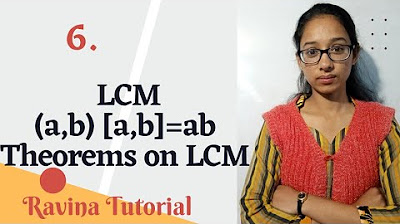MÚLTIPLOS de NÚMEROS NATURAIS |COMO CALCULAR MÚLTIPLOS | Matemática Básica \Prof. Gis/
Summary
TLDRIn this educational video, the presenter explains the concept of multiples in natural numbers, using multiplication tables to demonstrate how multiples are derived. Key concepts include the infinite nature of multiples and their relation to the multiplication of natural numbers. The video also covers strategies for identifying multiples, with examples such as multiples of 3, 8, and 9. Additionally, the presenter explains how to verify if a number is a multiple of another through division, ensuring that the remainder is zero for a valid multiple. The session encourages viewers to study multiplication tables for better understanding.
Takeaways
- 😀 Multiples are the result of multiplying a natural number by another natural number.
- 😀 The multiplication table (tabuada) is essential for understanding and calculating multiples.
- 😀 The sequence of multiples is infinite, meaning it never ends.
- 😀 Zero is always a multiple of any natural number.
- 😀 The multiples of a number can be listed by continuing its multiplication table.
- 😀 When asked to list multiples, pay attention to the instructions (e.g., 'list the first 5 multiples').
- 😀 Multiples are denoted using 'M' (e.g., M3 refers to multiples of 3).
- 😀 To check if a number is a multiple of another, you can list multiples or use division.
- 😀 If the result of division between two numbers has no remainder, the number is a multiple.
- 😀 The teacher encourages practicing the multiplication table to improve speed and accuracy with multiples.
- 😀 For some numbers, patterns in their multiples (like ending in specific digits) can help identify them quickly.
Q & A
What are multiples of a number?
-Multiples of a number are the results of multiplying that number by integers. For example, the multiples of 3 are 3, 6, 9, 12, 15, and so on.
Why is it important to study the multiplication table when learning about multiples?
-Studying the multiplication table helps you quickly identify multiples of a number. If you know the multiplication table, you can easily list the multiples of any number without confusion.
How do we represent the multiples of a number?
-We represent the multiples of a number using the notation M(n), where 'n' is the number and the set contains its multiples. For example, M(3) = {0, 3, 6, 9, 12, 15, ...}.
Are multiples of a number finite or infinite?
-Multiples of a number are infinite. No matter how far you go in the sequence, the multiples continue indefinitely.
How do we determine the first few multiples of a number?
-To determine the first few multiples of a number, we simply multiply that number by the integers 0, 1, 2, 3, and so on. For example, the first few multiples of 8 are 0, 8, 16, 24, 32, and so on.
What is the significance of zero in the context of multiples?
-Zero is a multiple of every natural number. This is because any number multiplied by zero results in zero (e.g., 3 × 0 = 0).
How do we check if a number is a multiple of another number?
-To check if a number is a multiple of another, you can either list the multiples or use division. If dividing the number by another results in a remainder of zero, it’s a multiple.
Is 81 a multiple of 9? How do you know?
-Yes, 81 is a multiple of 9 because 81 ÷ 9 = 9 with no remainder, which means it’s an exact division and thus a multiple.
Is 70 a multiple of 35? Explain how to check this.
-Yes, 70 is a multiple of 35 because 70 ÷ 35 = 2 with no remainder. Since the division is exact, 70 is a multiple of 35.
Can you use the division method to check if 97 is a multiple of 5?
-No, 97 is not a multiple of 5 because when dividing 97 by 5, you get a remainder of 2. This means the division is not exact, so 97 is not a multiple of 5.
Outlines

Cette section est réservée aux utilisateurs payants. Améliorez votre compte pour accéder à cette section.
Améliorer maintenantMindmap

Cette section est réservée aux utilisateurs payants. Améliorez votre compte pour accéder à cette section.
Améliorer maintenantKeywords

Cette section est réservée aux utilisateurs payants. Améliorez votre compte pour accéder à cette section.
Améliorer maintenantHighlights

Cette section est réservée aux utilisateurs payants. Améliorez votre compte pour accéder à cette section.
Améliorer maintenantTranscripts

Cette section est réservée aux utilisateurs payants. Améliorez votre compte pour accéder à cette section.
Améliorer maintenantVoir Plus de Vidéos Connexes

MÚLTIPLOS E DIVISORES - RESUMÃO - 6º e 7º ano

Kurikulum Merdeka Matematika Kelas 7 Bab 1 Bilangan Bulat

MMC - MÍNIMO MÚLTIPLO COMUM

6. LCM | gcd(a,b) lcm(a,b) = ab | Theorems on LCM | Ravina Tutorial | in Hindi

How To Find The LCM of 3 Numbers - Plenty of Examples!

BILANGAN BERPANGKAT (EKSPONEN) DAN SIFAT-SIFATNYA | PANGKAT BULAT POSITIF
5.0 / 5 (0 votes)
